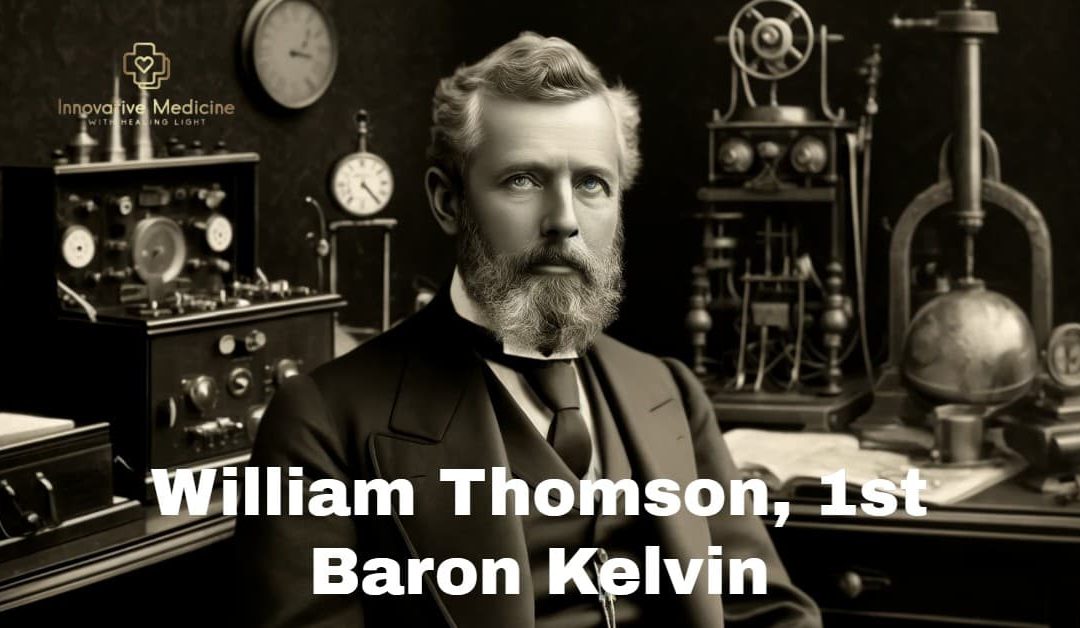Sir William Thomson or as many knew him, “Lord Kelvin,” was a mathematician, engineer, and physicist who lived in Scotland, United Kingdom. His thoughts and life greatly influenced the scientific world of the 19th century. Thanks to him, we know the absolute temperature scale, measured in Kelvin units, and contributions to thermodynamics, electricity, and magnetism, among others. He received different significant awards and also participated in the creation of a worldwide telegraphic communication network that would revolutionize the way of communicating between countries.
The Early Life of William Thomson
William Thomson, 1st Baron Kelvin was born on June 26 1824, in Belfast, the capital of Northern Ireland. His father was James Thomson, a mathematics teacher at the school where William began his studies: the Royal Belfast Academical Institution. His mother was Margaret Gardner. However, she and William did not live together long since she died when little Kelvin was only six years old.
His father transferred as a professor to the University of Glasgow, where at the age of 10, in 1834, William and his brother James entered the elementary studies section at the University of Glasgow in the class of advanced students. Little William was very interested in science. He stood out in his childhood for his intelligence. At the age of 15, he received an award in Astronomy from his class.
University
At 17, he managed to enter Cambridge University, Peterhouse College, where four years later he obtained a degree in mathematics with honors and received the first Smith Prize for research. While studying at Cambridge, he became very interested in electricity and thermodynamics, all thanks to Fourier and George Green, from whom he read and based his early formulations. Also, around this age, Thomson wrote at least three major articles defending Fourier’s work. He worked in the laboratory of a prestigious scientist named Henri Victor Regnault in 1845. It was at this time that he proposed the absolute temperature scale known as the Kelvin Scale, which is measured in Kelvin units. A year later, he returned to the University of Glasgow, where he had obtained a professorship in Natural Philosophy (Physics). He stayed in this role until 1899, when he left because of his age.
Thomson’s Great Achievement

It was in the year 1847 that William became interested in Joule’s theory of the interconvertibility of heat and motion. In the beginning, he believed that Joule was wrong, but when he delved into the subject, he recognized Joules theory and wrote an essay in 1851 where he gave his version of the second law of thermodynamics. This fact was a watershed for the unification of the scientific thought of the moment.
A year later, Thomson developed an important root idea from the reflections of an investigation by Michael Faraday that had to do with telegraph cables. This idea was what we know today as bandwidth. Thanks to this, in December of the same year, he managed to become a member of the board of directors, and the scientific advisor of the Atlantic Telegraph Company.
Atlantic Telegraph Company
It was at the Atlantic Telegraph Company that Lord Kelvin developed a complete system to operate the underwater telegraph capable of sending a character every three and a half seconds. As a result of these investigations, he invented and patented the gauge galvanometer and the symphonic recorder.
In 1866, after many failed attempts, William Thomson succeeded in developing the first undersea transatlantic cable with moorings at Heart’s Content (Newfoundland) and on the island of Valentia (Ireland); this drastically reduced the communication time between the United States and Europe from 12 days (Ship time) to minutes. Thanks to this development, Queen Victoria granted him the title of Sir.
The Growth of Sir William
It was also thanks to this William Thomson became a prominent figure and participated in the construction of other submarine cables, and together with other notable inventors, making an extensive global telegraphic communication network. Through these works, Thomson was able to accumulate a high wealth; he even bought a yacht in which he invented various tools for navigation. In 1892 he became part of the United Kingdom’s nobility and was awarded the title of Baron Kelvin of Largs.
Baron Kelvins Legacy

To summarize his contributions to the world of science and technological development, we can say that his main achievements were:
- He developed the second law of thermodynamics
- The absolute temperature scale (measured in Kelvin units)
- The dynamic theory of heat
- The mathematical analysis of electricity and magnetism, including the basic ideas of the electromagnetic theory of light
- Geophysical determination of the age of the Earth
- Fundamental work in hydrodynamics.
His work on submarine telegraphy and his inventions for use on submarine cables helped Great Britain to conquer a preeminent place in world communication during the 19th century.
Medals Received by Baron Kelvin
Throughout his life, William Thomson received different medals and recognitions. The most outstanding recognitions to Lord Kelvin were:
- In 1856, the Royal Medal, for his various researches relating to electricity
- In 1873, the Poncelet Prize, for his works on the mathematical theory of electricity and magnetism
- In 1876 the Matteucci Medal, an Italian award for physicists
- In 1879, the Albert Medal, for his electrical researches, especially for to the transmission of telegraphic messages over ocean cables
- In 1883, the Copley Medal, for his discovery of the law of the universal dissipation of energy and his research in physics, especially in the theory of electricity and thermodynamics
Lord Kelvins Last Days
On December 17, 1907, William Thomson died in Scotland, United Kingdom, in a town called Netherhall. His remains were interred in Westminster Abbey, next to Isaac Newton’s grave, where they remain to this day.

